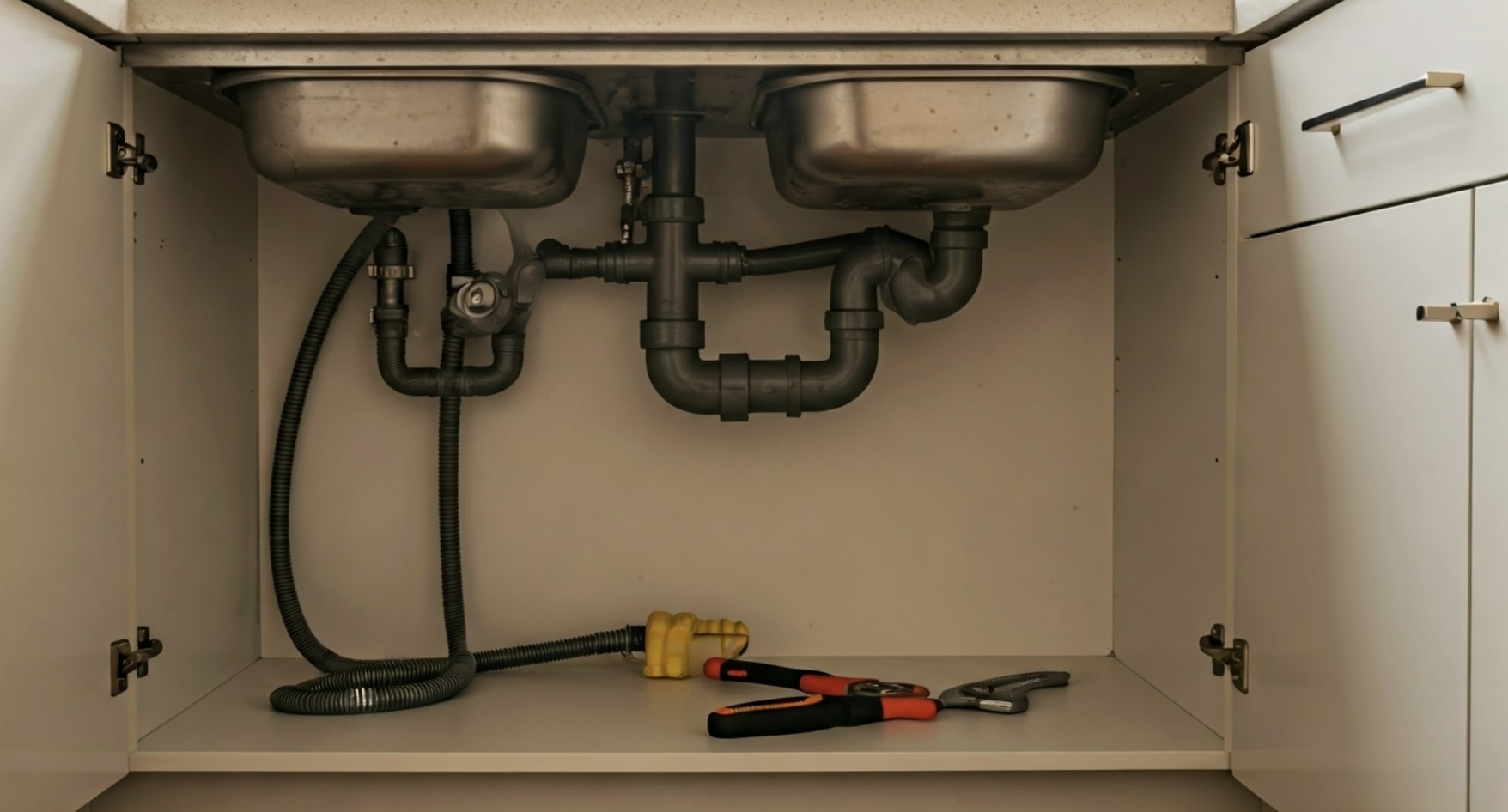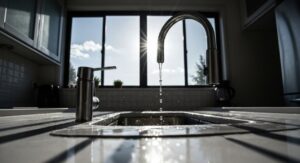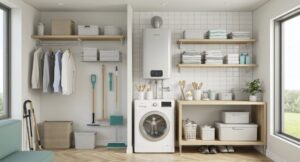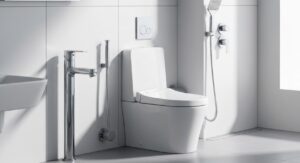Plumbing plays a vital role in your home, delivering fresh water where you need it and carrying waste away efficiently. Whether you’re a first-time homeowner or an experienced DIYer, understanding your home’s plumbing system can save you money, time, and stress. This essential plumbing guide for homeowners breaks down the key plumbing system components, common issues, and maintenance strategies. With this foundational knowledge, you’ll feel empowered to tackle routine maintenance, identify potential problems, and know when to call plumbing services for help.
Understanding Home Plumbing Systems
A home’s plumbing system is a complex network that keeps daily life running smoothly. It includes three main subsystems:
Water Supply Lines and How They Work
Water supply lines are the lifeblood of your home’s plumbing system. These pressurized pipes draw water from a municipal supply or private well, distributing it throughout your house to sinks, showers, toilets, and appliances. Copper and cross-linked polyethylene (PEX) are common materials, valued for their durability and flexibility.
When you turn on a faucet, supply lines instantly deliver water at the right pressure. This allows several fixtures to be used at once without a dip in flow. The system is designed for reliability, ensuring that both hot and cold water reach every corner of your home’s plumbing system.
Pressure is key: unlike drainage, supply lines push water to its destination. Regular maintenance, such as checking for leaks and corrosion, will help these lines serve your home efficiently. Understanding this element gives you the confidence to address small issues or explain concerns to a professional plumber.
Drainage and Venting Basics
Drainage and venting form the vital exit route for wastewater in your plumbing system. Instead of pressure, drainage pipes rely on gravity—water and waste travel downhill, guided by pipes sloped at about a quarter inch per foot. Most modern homes use PVC or ABS pipes for this job, while older homes might have cast iron lines.
Venting keeps things flowing smoothly. Vent pipes let air into the drainage system, preventing vacuums that can stop water from moving or suck water out of plumbing traps—those curved pipes under sinks and toilets. Without proper venting, sewer gases can escape into your living space, causing odors and health concerns.
Together, these systems safeguard your home by removing waste efficiently and blocking unpleasant gases. If you notice slow drains or foul odors, your drainage or venting might need attention—a key reason to stay alert and know when to call for professional plumbing services.
Key Components of Residential Plumbing
Every home’s plumbing system relies on several key components working together seamlessly. Pipes and fittings create the pathways for water to move in and out, while valves control and direct water flow to different fixtures and appliances.
Pipes, Fittings, and Valves Explained
Pipes form the core structure of your home’s plumbing system, carrying water to and from fixtures. Fittings connect these pipes together, change their direction, or adjust their size. Valves play a crucial role in controlling water flow—allowing you to shut off water to the whole house or isolate a specific area for repairs.
| Component | Description | Common Materials |
|---|---|---|
| Pipes | Transport water supply or wastewater throughout the home | Copper, PEX, PVC, ABS, Cast Iron |
| Fittings | Join pipes, alter direction, adapt sizes, or link different materials | Brass, Copper, Plastic |
| Valves | Stop, start, or control water flow at various points | Brass, Ball-type, Gate-type |
Properly installed pipes, secure fittings, and reliable valves keep your home’s plumbing system leak-free and efficient. Always use the right parts and materials to prevent future issues, and don’t hesitate to contact a professional plumber if you encounter unfamiliar problems.
Common Fixtures and Appliances
Fixtures and appliances are the most visible part of your home’s plumbing system—the points where you interact with water every day. These elements need to function reliably to ensure comfort and hygiene.
Think of:
- Sinks and faucets in kitchens and bathrooms for washing and cooking.
- Toilets, which use water supply and drainage for safe waste removal.
- Showers and bathtubs, designed for personal care and relaxation.
- Dishwashers and washing machines, which automate cleaning tasks and connect directly to both supply and drainage.
- Water heaters, providing hot water where it’s needed most.
Many modern fixtures now include water-saving features, like low-flow showerheads and dual-flush toilets, to help conserve water. Keeping these components well-maintained protects the overall plumbing system and can reduce your water bills. If you have persistent issues with any fixture, a professional plumber can diagnose and resolve the problem.
Must-Have Plumbing Tools for Homeowners
Every homeowner should keep a basic set of plumbing tools handy for routine repairs and emergencies. These tools help maintain your home’s plumbing system and often allow for quick fixes that can prevent costly damage.
Your toolkit should include:
- Plunger: Essential for clearing clogs in toilets and sinks.
- Adjustable wrench: Useful for tightening or loosening nuts and fittings.
- Pipe wrench: Provides extra grip on larger pipes and stubborn connections.
- Plumber’s tape (Teflon tape): Seals threaded pipe joints to prevent leaks.
- Drain snake or auger: Clears deep blockages in drains without harsh chemicals.
- Bucket and towels: For catching water and containing spills during repairs.
Having these tools ready allows you to act quickly when plumbing issues arise. “The right tools can turn a plumbing crisis into a manageable fix,” says Richard Trethewey, renowned plumbing expert.
Safety Equipment and Protective Gear
Safety should always come first when working on your home’s plumbing. The right protective gear shields you from potential hazards such as sharp objects, hot water, and contaminated wastewater.
Essential safety equipment includes:
- Work gloves: Protect your hands from cuts, chemicals, and dirty water.
- Safety glasses: Shield your eyes from splashes or flying debris during repairs.
- Kneepads: Keep you comfortable and reduce strain when working under sinks or in tight spaces.
In addition to basic protection, consider wearing a mask if you’re dealing with mold, dust, or strong odors. Always ensure your workspace is well-lit and ventilated. By using proper safety gear, you reduce the risk of injury and make your plumbing projects safer and more efficient.
Beginner’s Guide: Getting Started with Basic Plumbing Tasks
Preparation is the first step to any successful plumbing project. Before you begin, make sure you have the right plumbing supplies on hand, know the location of key plumbing components, and understand what you intend to repair.
To get started, gather:
- The essential tools from your homeowner’s plumbing toolkit.
- Safety equipment such as gloves, glasses, and towels.
- Replacement parts or plumbing supplies for the task at hand (washers, O-rings, pipe joints).
- A clear plan for accessing and shutting off water to the area you’re working on.
Check that your workspace is dry, well-lit, and free of hazards. Taking these steps ensures a smoother repair process and helps you avoid costly mistakes. If you’re ever unsure, consult a professional plumber or local plumbing services for guidance.
Step 1: Locating Shut-Off Valves
Knowing how to quickly locate and operate shut-off valves is essential for every homeowner. These valves control water flow to your entire house or specific fixtures, helping you stop leaks and prevent water damage during repairs.
Start by finding your main shut-off valve—often in the basement, utility room, or outside (in warmer climates). Turn it off to stop water to the entire house. Fixture-level shut-offs are found under sinks, behind toilets, or near appliances, allowing you to isolate problems without affecting the rest of the home’s plumbing.
Exercise all shut-off valves at least once a year by turning them on and off. This keeps them from sticking due to mineral buildup and ensures they’ll work in an emergency. By mastering this skill, you gain peace of mind and can act quickly when plumbing issues arise.
Step 2: Checking for Leaks and Drips
Catching leaks and drips early is one of the most important ways to protect your plumbing system and your home. Even a slow drip can waste gallons of water and lead to expensive repairs over time.
Begin by inspecting all visible pipes, faucets, and under-sink areas for moisture or water stains. Listen for the sound of dripping water. To catch hidden leaks, turn off all water-using appliances and check your water meter—if it moves, you might have a leak somewhere in the home’s plumbing.
Pay special attention to areas behind appliances and inside cabinets. Mold, warped wood, or musty odors are clues that a hidden leak could be at work. “Regular inspection is key to preventing water damage before it happens,” says Richard Trethewey. If you can’t find the source or fix it yourself, contact a professional plumber for help.
Choose Us at Target Plumbers for Dependable Plumbing Solutions
When plumbing problems go beyond your comfort zone, having a trusted professional plumber makes all the difference. At Target Plumbers, we offer expert plumbing services designed to address every aspect of your home’s plumbing system—from routine inspections to emergency repairs.
Our team uses the latest tools and proven techniques to diagnose and fix leaks, restore water pressure, and replace worn-out components. We understand how disruptive plumbing issues can be, so we prioritize rapid response and lasting results that keep your home comfortable and safe.
For homeowners who value reliability and transparency, Target Plumbers is your go-to solution. Whether it’s a persistent clog, a hidden leak, or an upgrade to more efficient fixtures, our skilled professionals are ready to help. Contact us today, and let us keep your home’s plumbing system running at its best.
Conclusion
In conclusion, understanding the essential plumbing guide for homeowners like you is crucial for every homeowner. By familiarizing yourself with the various components of your home’s plumbing system, from water supply lines to drainage basics, you can tackle minor issues effectively and prevent costly repairs. Equipping yourself with the right tools and knowledge on basic plumbing tasks will empower you to handle everyday challenges with confidence. Remember, proactive maintenance is key.
Discover the Top 10 Plumbing Problems Every Homeowner Should Know.
Frequently Asked Questions
How can I spot hidden plumbing leaks before they cause damage?
Check your plumbing system regularly for unexplained water stains, musty odors, or increased water bills. Turn off all water fixtures and monitor your water meter—if it continues to move, you likely have a hidden leak. For persistent concerns, contact a professional plumber or plumbing services for a thorough inspection.
What are the most common plumbing emergencies and how should I respond?
Burst pipes, overflowing toilets, and severe clogs are frequent plumbing emergencies. Shut off the main water valve immediately to stop water flow, contain any spills, and avoid further damage. For major issues, call a professional plumber or emergency plumbing services right away for fast assistance.
Which plumbing tips help prevent costly repairs?
Regularly check for leaks, keep drains clear with screens, insulate exposed pipes, and know how to use shut-off valves. Scheduling annual inspections with a professional plumber ensures early detection of issues. Proactive care is the best way to keep your home’s plumbing system running smoothly.
Are there signs that my plumbing system needs professional attention?
Yes—look for persistent leaks, slow or gurgling drains, foul odors, unexplained water bills, or drops in pressure. If any of these occur, it’s time to call a professional plumber for reliable plumbing services. Early intervention protects your home’s plumbing and prevents bigger problems down the line.






